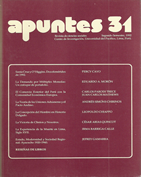The experience of death in Lima: XVII century
DOI:
https://doi.org/10.21678/apuntes.31.359Keywords:
Peru, death, history, colonial countriesAbstract
Death occupied a prominent spot in colonial Lima. Day-to-day violence, the precariousness of life and the constant preachings about the day of judgement were ever-present and contributed to this state of affairs. The proximity of death, whether it be inexorable, or the possibility of being the victim of a sudden death, led people to try to prepare themselves properly for a “good death”, absolutely vital if one wanted to ensure eternal salvation. This would take the form of elaborate ritualism in the funerary rites. In addition, there was an appeal for solidarity between the living and the dead. The deceased would continue to play a role in society, while the living with their prayers could help relieve the tormented of their dear departed. In this way, the line between life and death was not clearly defined.Downloads
Download data is not yet available.
Downloads
Published
1992-12-08
How to Cite
Barriga Calle, I. (1992). The experience of death in Lima: XVII century. Apuntes. Social Sciences Journal, (31), 81–101. https://doi.org/10.21678/apuntes.31.359
Issue
Section
Articles
License
Apuntes publishes all its articles and reviews under a Creative Commons Attribution (CC BY 4.0) license with the objective of promoting academic exchange worldwide. Therefore, articles and book reviews can be distributed, edited, amended, etc., as the author sees fit. The only condition is that the name of the author(s) and Apuntes. Revista de Ciencias Sociales (as the publisher) be cited.



.jpg)
